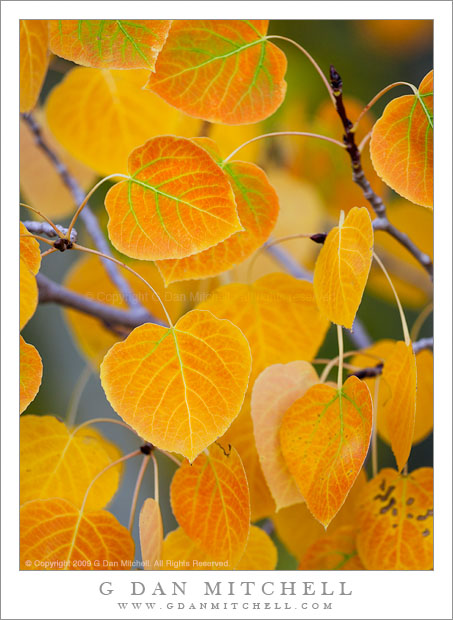
Aspen Leaves in Transition – Near Conway Summit. Sierra Nevada, California. September 27, 2009. © Copyright 2009 G Dan Mitchell – all rights reserved.
Aspen leaves in transition from green to fall hues in the shade of a grove above Conway Summit, Sierra Nevada, California.
This is another of my close-up aspen detail photographs from my one-hour or so shoot in the eastern Sierra near Conway Summit on the last Sunday of September. I took a quick detour to this part of the “east side” after completing a short photographic backpack trip to Cathedral Lakes that weekend.
I’ve photographed this grove before, so I stop every season and see what I can find. This time I think I arrived a few days earlier than usual in the color transition. There were still a lot more leaves on trees in the grove than I’ve seen in the past and a nearby grove was still completely green. (This grove is among the first you encounter as you drive up the road from Highway 395/Conway Summit toward Virginia Lake, right by a dirt road turnoff on the left side.)
As I walked into the lower edge of the grove, I discovered that among leaves that were for the most part either green or yellow, there were a few here that had a wider range of colors – some residual green, yellow, gold, orange, and even verging on red. So, in addition to shooting the larger view of the grove, I decided to use a long lens and work on a few close shots of the leaves that most caught my attention.
 G Dan Mitchell is a California photographer and visual opportunist whose subjects include the Pacific coast, redwood forests, central California oak/grasslands, the Sierra Nevada, California deserts, urban landscapes, night photography, and more.
G Dan Mitchell is a California photographer and visual opportunist whose subjects include the Pacific coast, redwood forests, central California oak/grasslands, the Sierra Nevada, California deserts, urban landscapes, night photography, and more.
Blog | About | Flickr | Twitter | Facebook | Google+ | 500px.com | LinkedIn | Email
Text, photographs, and other media are © Copyright G Dan Mitchell (or others when indicated) and are not in the public domain and may not be used on websites, blogs, or in other media without advance permission from G Dan Mitchell.

